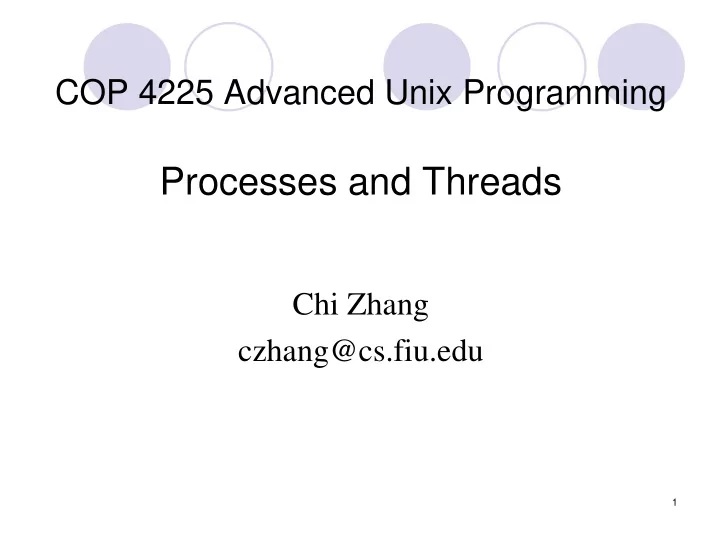

COP 4225 Advanced Unix Programming Processes and Threads Chi Zhang czhang@cs.fiu.edu 1
Process Concept � Process – a program in execution; process execution must progress in sequential fashion. � A process includes � program counter � stack � data section � (p.168 Figure 7.3): 2
Process State � As a process executes, it changes state � new : The process is being created. � running : Instructions are being executed. � waiting : The process is waiting for some event to occur. � ready : The process is waiting to be assigned to a process. � terminated : The process has finished execution. 3
Diagram of Process State 4
Process Control Block (PCB) Pointer to the next process 5
CPU Switch From Process to Process 6
Process Scheduling Queues � Job queue – set of all processes in the system. � Ready queue – set of all processes residing in main memory, ready and waiting to execute. � Device queues – set of processes waiting for a particular I/O device. � Process migration between the various queues. 7
Representation of Process Scheduling 8
Schedulers � Long-term scheduler � which processes should be brought into the ready queue (in memory rather than on disk). � invoked very infrequently (when a process leave the system) � Short-term scheduler � selects which process should be executed next and allocates CPU. � Invoked frequently � Midterm scheduler � Swapping improves the process mix. 9
Context Switch � When CPU switches to another process, the system must save the state of the old process and load the saved state for the new process. � Context-switch time is overhead; the system does no useful work while switching. � Time dependent on hardware support. 10
Process Creation � Parent process create children processes, which, in turn create other processes, forming a tree of processes. � Resource sharing � Parent and children share all resources. � Children share subset of parent’s resources. � Parent and child share no resources. � Execution � Parent and children execute concurrently. � Parent waits until children terminate. 11
Processes Tree on a UNIX System 12
Process Termination � Process executes last statement and asks the operating system to decide it ( exit ). � Output data from child to parent (via wait ). � Process’ resources are deallocated by operating system. � Parent may terminate execution of children processes ( abort ). � Child has exceeded allocated resources. � Task assigned to child is no longer required. � Parent is exiting. � Operating system does not allow child to continue if its parent terminates. � Cascading termination. 13
Single and Multithreaded Processes 14
Benefits � Responsiveness � User interaction in parallel with data retrieval � Resource Sharing � Economy � In Solaris 2, creating a process is about 30 times slower than threads � Context switch is about 5 times slower. � Utilization of MP Architectures 15
User Threads � Thread management done by user-level threads library � A blocking system call will cause the entire process to block � OS is unaware of threads � The kernel cannot schedule threads on different CPUs. 16
Many-to-One Model (User Threads) 17
Kernel Threads � Supported by the Kernel � OS manages threads � Slower to create and manage because of system calls � A blocking system call will not cause the entire process to block. � The kernel can schedule threads on different CPUs. 18
Many-to-Many Model (Solaris 2) � Allows many user level threads to be mapped to many kernel threads. � Allows the operating system to create a sufficient number of kernel threads. 19
Many-to-Many Model 20
Threading Issues � Semantics of fork() and exec() system calls. � Duplicate all threads in the child process? � Thread cancellation. � Asynchronous Cancellation � One thread immediately terminates the target thread � OS reclaims resources (but not all) allocated to the threads � Deferred Cancellation � The target thread checks periodically if it should terminate (if so, terminate gracefully) 21
Threading Issues � Signal handling � Which thread should a signal be delivered � Thread pools � Creating threads upon incoming request is expensive � Unlimited Threads can exhaust system resources � Request queue + thread pool � Thread specific data 22
Pthreads � a POSIX standard (IEEE 1003.1c) API for thread creation and synchronization. � API specifies behavior of the thread library, implementation is up to development of the library. � Common in UNIX operating systems. 23
Solaris 2 Threads � Light Weight Threads (LWP) between user- and kernel- level threads. � Each LWP is mapped to one kernel-level thread � The thread library (user level) multiplexes (schedules) user-level threads on the pool of LWPs for the process. � Only user-level threads currently connected to an LWP accomplish work � For one process, one LWP is needed for every thread that may block concurrently in system calls. 24
Solaris 2 Threads 25
Solaris Process The kernel maintains Process control block, kernel threads, and LWPs. The user-level threads is maintained in the user space. 26
Linux Threads � Linux refers to them as tasks rather than threads . � Linux actually does not distinguish between processes and threads � Thread creation is done through clone() system call. � Clone() allows a child task to share the address space of the parent task (process) � A set of parameters decides how much of the parent process is to be shared with the child. � User-level Pthread implementation is also available 27
Recommend
More recommend